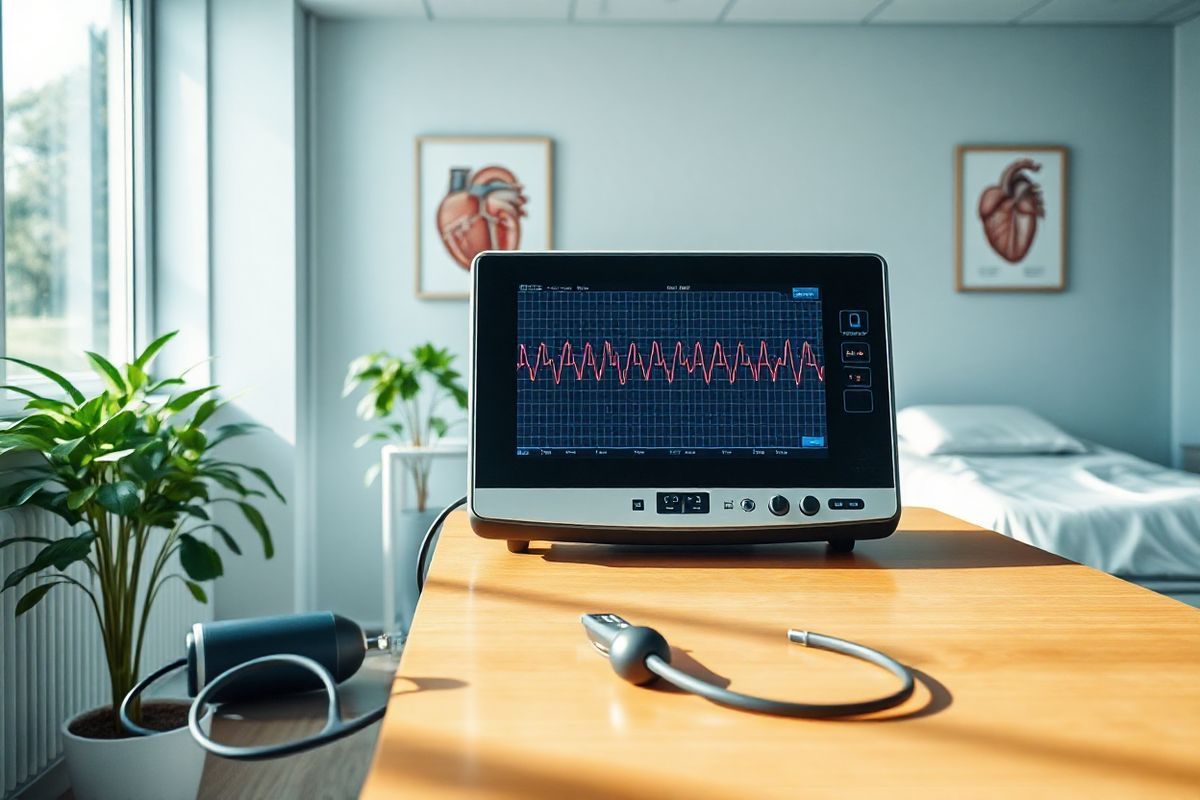Table of Contents
Understanding Ventricular Tachycardia: What You Need to Know About This Life-Threatening arrhythmia

Ventricular tachycardia (VT) is a type of arrhythmia characterized by an abnormal heart rhythm that originates from the ventricles, the heart’s lower chambers. Unlike normal heartbeats, which are initiated by electrical impulses from the sinoatrial (SA) node, VT occurs when these electrical impulses malfunction, causing the ventricles to beat too quickly, often exceeding 100 beats per minute. This rapid rate can prevent the heart from filling properly, leading to reduced cardiac output and potentially life-threatening situations (UCSF Health, 2023).
VT is often classified into two main categories: sustained and nonsustained. Sustained VT lasts more than 30 seconds or requires intervention due to hemodynamic instability. Nonsustained VT lasts less than 30 seconds and may resolve on its own without intervention. The pathophysiology of VT typically involves structural heart disease, such as ischemic heart disease, cardiomyopathy, or congenital heart defects, where scarring or abnormal electrical pathways facilitate the development of rapid heart rhythms (UCSF Health, 2023).
Understanding the underlying causes of VT is crucial for effective management. Conditions such as myocardial infarction, heart failure, and electrolyte imbalances can predispose individuals to this arrhythmia. Genetic factors also play a role; for instance, inherited conditions like Long QT syndrome can increase the risk of developing VT. As such, a comprehensive assessment of a patient’s cardiac health, medical history, and family history is essential in identifying the underlying causes of VT.
Identifying the Symptoms: How to Recognize Ventricular Tachycardia Early
Recognizing the symptoms of VT early can be life-saving. Common manifestations include:
- Palpitations: Patients may feel a rapid or irregular heartbeat, often described as fluttering or pounding.
- Dizziness or Lightheadedness: Due to decreased blood flow to the brain, patients may experience dizziness or fainting spells.
- Chest Pain: Some patients report discomfort or pressure in the chest, which can be mistaken for angina or a heart attack.
- Shortness of Breath: Rapid heart rates can lead to inadequate oxygenation, resulting in breathing difficulties.
- Fatigue: The heart’s inability to pump effectively can cause overall fatigue and weakness.
- Fainting (Syncope): In severe cases, patients may lose consciousness due to inadequate blood flow to the brain.
Interestingly, some patients may experience no symptoms at all, particularly with nonsustained VT. This lack of symptoms makes regular cardiac evaluations vital for those at risk (UCSF Health, 2023).
Diagnostic Approaches: Evaluating Ventricular Tachycardia and Other arrhythmias
Diagnosis of VT involves a combination of patient history, physical examination, and advanced diagnostic tools. The following methods are commonly utilized in the evaluation of VT:
Electrocardiogram (ECG)
An ECG is a primary tool for diagnosing VT. It records the electrical activity of the heart and can reveal the characteristic patterns associated with VT, such as wide QRS complexes. Distinguishing between VT and other arrhythmias, such as atrial fibrillation with a rapid ventricular response, is critical, as treatment differs significantly.
Holter Monitor
A Holter monitor is a portable ECG device worn by the patient for 24 to 48 hours to capture intermittent arrhythmias that may not be detected during a standard ECG. This tool is particularly useful for patients experiencing nonsustained VT or those with sporadic symptoms.
Electrophysiology Study
For patients with recurrent VT or those not responding to initial treatments, an electrophysiology (EP) study may be recommended. This invasive procedure involves threading catheters through blood vessels to the heart, allowing for direct measurement of electrical signals and identification of the arrhythmogenic focus. EP studies can also guide treatment options such as catheter ablation (UCSF Health, 2023).
Imaging Techniques
Echocardiography is often employed to assess the heart’s structure and function. It can help identify underlying cardiac conditions, such as cardiomyopathy or valvular heart disease, that may predispose individuals to VT. Cardiac MRI may also be utilized for detailed imaging, particularly in cases of structural heart disease.
Treatment Options: Effective Strategies for Managing Ventricular Tachycardia

Management of VT depends on the type, duration, and underlying cause. Treatment strategies may include:
Medications
Antiarrhythmic drugs are often the first line of defense in managing VT. Medications such as amiodarone, sotalol, or lidocaine can help stabilize the heart’s electrical activity and prevent recurrent episodes. The choice of medication is influenced by the patient’s overall health status, the presence of other medical conditions, and response to prior treatments (UCSF Health, 2023).
Catheter Ablation
For patients with recurrent or symptomatic VT, catheter ablation offers a curative approach. This procedure involves delivering radiofrequency energy to destroy the abnormal electrical pathways responsible for VT. Catheter ablation has shown high success rates and can significantly improve the quality of life for patients who are intolerant to medications (UCSF Health, 2023).
Implantable Cardioverter Defibrillator (ICD)
In patients at high risk for sudden cardiac arrest due to VT, an implantable cardioverter defibrillator (ICD) may be recommended. This device continuously monitors the heart’s rhythm and delivers an electrical shock to restore normal rhythm if a life-threatening arrhythmia is detected. ICDs have been proven to reduce mortality in patients with a history of life-threatening VT or ventricular fibrillation (UCSF Health, 2023).
Lifestyle Modifications
Lifestyle changes can play a crucial role in managing VT, particularly in patients with underlying conditions. Recommendations may include maintaining a heart-healthy diet, engaging in regular physical activity, managing stress, and avoiding stimulants such as caffeine and nicotine. For those with heart disease, cardiac rehabilitation programs can provide structured support to improve cardiovascular health and reduce the risk of arrhythmias.
Preventive Measures: Reducing the Risk of Ventricular Tachycardia Recurrence
Preventing recurrent episodes of VT involves a multifaceted approach:
- Regular Follow-up: Routine follow-up with a cardiologist can help monitor heart health and adjust treatment as needed.
- Medication Adherence: Ensuring compliance with prescribed medications is essential for maintaining stable heart rhythms.
- Monitoring Risk Factors: Managing risk factors such as hypertension, diabetes, and hyperlipidemia can significantly reduce the likelihood of VT.
- Education: Patient education about recognizing symptoms and understanding the importance of early intervention can enhance outcomes.
TablCommon Medications for Ventricular Tachycardia
| Medication | Mechanism of Action | Common Side Effects |
|---|---|---|
| Amiodarone | Prolongs the action potential and refractory period | Thyroid dysfunction, pulmonary toxicity |
| Sotalol | Beta-blocker with potassium channel blocking effects | Fatigue, dizziness, bradycardia |
| Lidocaine | Sodium channel blocker | Drowsiness, confusion |
| Dofetilide | Potassium channel blocker | Proarrhythmia, headache |
FAQ Section
What is ventricular tachycardia?
Ventricular tachycardia (VT) is a fast heart rhythm originating from the ventricles, often leading to inadequate blood flow to the body and potentially life-threatening complications.
What are the symptoms of VT?
Common symptoms include palpitations, dizziness, chest pain, shortness of breath, fatigue, and fainting. Some patients may experience no symptoms.
How is VT diagnosed?
Diagnosis typically involves an ECG, Holter monitor, electrophysiology study, and imaging techniques like echocardiography to assess heart structure and function.
What treatments are available for VT?
Treatment options include antiarrhythmic medications, catheter ablation, implantable cardioverter defibrillators (ICDs), and lifestyle modifications.
Can VT be prevented?
Preventive measures focus on regular follow-up care, medication adherence, monitoring risk factors, and patient education to recognize symptoms early.
References
- UCSF Health. (2023). Ventricular Tachycardia. Retrieved from https://www.ucsfhealth.org/conditions/ventricular-tachycardia
- Much More Than a Stroke: Emery-Dreifuss Muscular Dystrophy Type 2 Revealed by Ischemic Stroke. Retrieved from https://doi.org/10.7759/cureus.73815
- Identification and development of TRPM4 antagonists to counteract neuronal excitotoxicity. Retrieved from https://doi.org/10.1016/j.isci.2024.111425
- Advancements in Inpatient Medical Management of Malnutrition in Children and Adolescents with Restrictive Eating Disorders. Retrieved from https://doi.org/10.1016/j.jpeds.2023.113482
- Primary Cardiac Leiomyosarcoma Extending From Right Atrium to Inferior Vena Cava Without Metastasis: A Case Report. Retrieved from https://doi.org/10.7759/cureus.73826
- The role of the radiologist in the dengue endemic: a pictorial essay. Retrieved from https://pubmed.ncbi.nlm.nih.gov/11649009/











